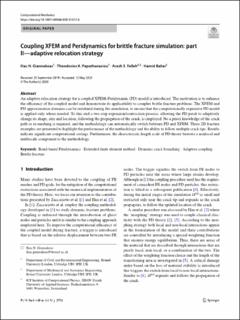Please use this identifier to cite or link to this item:
https://doi.org/10.21256/zhaw-20267| Publication type: | Article in scientific journal |
| Type of review: | Peer review (publication) |
| Title: | Coupling XFEM and peridynamics for brittle fracture simulation—part II : adaptive relocation strategy |
| Authors: | Giannakeas, Ilias N. Papathanasiou, Theodosios K. Soleiman Fallah, Arash Bahai, Hamid |
| et. al: | No |
| DOI: | 10.1007/s00466-020-01872-8 10.21256/zhaw-20267 |
| Published in: | Computational Mechanics |
| Volume(Issue): | 66 |
| Issue: | 3 |
| Page(s): | 683 |
| Pages to: | 705 |
| Issue Date: | 4-Jul-2020 |
| Publisher / Ed. Institution: | Springer |
| ISSN: | 1432-0924 0178-7675 |
| Language: | English |
| Subjects: | XFEM peridynamic coupling; Bond-based peridynamics; Extended finite element method; Dynamic crack branching; Adaptive coupling; Brittle fracture |
| Subject (DDC): | 530: Physics |
| Abstract: | An adaptive relocation strategy for a coupled XFEM–Peridynamic (PD) model is introduced. The motivation is to enhance the efficiency of the coupled model and demonstrate its applicability to complex brittle fracture problems. The XFEM and PD approximation domains can be redefined during the simulation, to ensure that the computationally expensive PD model is applied only where needed. To this end a two-step expansion/contraction process, allowing the PD patch to adaptively change its shape, size and location, following the propagation of the crack, is employed. No a priori knowledge of the crack path or re-meshing is required, and the methodology can automatically switch between PD and XFEM. Three 2D fracture examples are presented to highlight the performance of the methodology and the ability to follow multiple crack tips. Results indicate significant computational savings. Furthermore, the characteristic length scale of PD theory bestows a nonlocal and multiscale component to the methodology. |
| URI: | https://digitalcollection.zhaw.ch/handle/11475/20267 |
| Fulltext version: | Published version |
| License (according to publishing contract): | CC BY 4.0: Attribution 4.0 International |
| Departement: | School of Engineering |
| Organisational Unit: | Institute of Computational Physics (ICP) |
| Appears in collections: | Publikationen School of Engineering |
Files in This Item:
| File | Description | Size | Format | |
|---|---|---|---|---|
| 2020_Giannakeas-etal_Coupling-XFEM-and-peridynamics-II.pdf | 9.03 MB | Adobe PDF |  View/Open |
Show full item record
Giannakeas, I. N., Papathanasiou, T. K., Soleiman Fallah, A., & Bahai, H. (2020). Coupling XFEM and peridynamics for brittle fracture simulation—part II : adaptive relocation strategy. Computational Mechanics, 66(3), 683–705. https://doi.org/10.1007/s00466-020-01872-8
Giannakeas, I.N. et al. (2020) ‘Coupling XFEM and peridynamics for brittle fracture simulation—part II : adaptive relocation strategy’, Computational Mechanics, 66(3), pp. 683–705. Available at: https://doi.org/10.1007/s00466-020-01872-8.
I. N. Giannakeas, T. K. Papathanasiou, A. Soleiman Fallah, and H. Bahai, “Coupling XFEM and peridynamics for brittle fracture simulation—part II : adaptive relocation strategy,” Computational Mechanics, vol. 66, no. 3, pp. 683–705, Jul. 2020, doi: 10.1007/s00466-020-01872-8.
GIANNAKEAS, Ilias N., Theodosios K. PAPATHANASIOU, Arash SOLEIMAN FALLAH und Hamid BAHAI, 2020. Coupling XFEM and peridynamics for brittle fracture simulation—part II : adaptive relocation strategy. Computational Mechanics. 4 Juli 2020. Bd. 66, Nr. 3, S. 683–705. DOI 10.1007/s00466-020-01872-8
Giannakeas, Ilias N., Theodosios K. Papathanasiou, Arash Soleiman Fallah, and Hamid Bahai. 2020. “Coupling XFEM and Peridynamics for Brittle Fracture Simulation—Part II : Adaptive Relocation Strategy.” Computational Mechanics 66 (3): 683–705. https://doi.org/10.1007/s00466-020-01872-8.
Giannakeas, Ilias N., et al. “Coupling XFEM and Peridynamics for Brittle Fracture Simulation—Part II : Adaptive Relocation Strategy.” Computational Mechanics, vol. 66, no. 3, July 2020, pp. 683–705, https://doi.org/10.1007/s00466-020-01872-8.
Items in DSpace are protected by copyright, with all rights reserved, unless otherwise indicated.